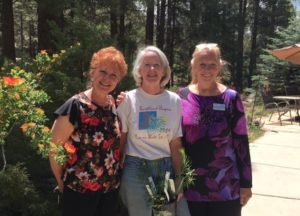 Mike Wagner carefully examines shelves of milkweed plants growing in the Northern Arizona University Greenhouse. Of the 30 milkweed species native to Arizona, 15 are being cultivated here from wild seeds. They are also sharing a room with a tropical milkweed topped in bright pink flowers that Wagner calls “a monarch magnet.”
Mike Wagner carefully examines shelves of milkweed plants growing in the Northern Arizona University Greenhouse. Of the 30 milkweed species native to Arizona, 15 are being cultivated here from wild seeds. They are also sharing a room with a tropical milkweed topped in bright pink flowers that Wagner calls “a monarch magnet.”
Wagner, Ph.D., an NAU Regents Professor Emeritus, is among a number of entomologists and educators concerned about the striking orange and black monarch butterfly. The population has declined by 90 percent in the last 20 years, according to Butterfly Wonderland in Scottsdale. Scientists believe climate change, pesticides and a loss of habitat are contributing to the dramatic drop in numbers.
Habitat loss is one factor Wagner believes he, along with NAU School of Forestry researchers and gardeners from Central to Northern Arizona can improve upon by planting more milkweed. “I can’t imagine anyone having the experience of walking through literally a sea of migrating monarchs and not being moved by what they see. They are such spectacular animals, such a spectacular part of our system.”
Migrating monarchs lumber through Arizona on their journey from Canada to Mexico in September and October. Their arrival near Mexico City is observed during Day of the Dead celebrations on Nov. 1. “In that culture, the return of the monarchs is the return of their loved ones’ spirits,” says Butterfly Wonderland Director of Education Adriane Grimaldi. “It’s a very jubilant time for the people there. There’s a big parade, and butterflies literally cover the sky as they go to hibernate in the same oyamel fir trees each year.”
Adult monarchs feed on a number of different flowers, but the females only lay eggs on milkweed leaves because those are the only plants the hatching larvae, or caterpillars, will eat. Wagner wants to give the butterflies a lift by cultivating hardy and abundant habitat. He’s looking for genetically superior milkweeds that are especially attractive to monarchs.
“We are paying attention to the parent plants that we find in nature. So, when we’re looking to find plants that are a source of seed. Within a species, we can find some very big differences in how well the plants will grow,” he explained. “For example, we have something called Antelope Horn Milkweed and we found a really vigorous beautiful plant in the wild last year. We collected seed from that plant and now we’re growing it in the greenhouse. That particular plant produces much more superior, faster growing, very vigorous, very healthy plants compared to some of the other parents that we’ve used in the past.”
Wagner’s goal is to get the best milkweed plants growing in as many urban environments as possible in Central and Northern Arizona so monarchs have many options for laying their eggs. “Anywhere people can find a spot in their yard, they can grow milkweeds.”
He has enlisted the support of Master Gardeners from the Verde Valley to Flagstaff. In exchange for free milkweeds to plant, Wagner asks for their observations as citizen scientists. “They agree that they will fill out a report twice a year and basically tell us how well the milkweeds do. So, they measure the plants, they look for butterflies on the plants, they see how the plants are doing overall and they report back to us. We will find out, for example, that in Prescott Valley, a certain milkweed species grows particularly well. In Flagstaff, maybe a different set of milkweeds will grow really well.”
Master gardener Linda Guarino has been involved in the milkweed research since last year. She manages the gardens as a volunteer at the Oliva White Hospice House in Flagstaff.
“There are eight different species that we’re planting from different elevations collected at different places in Arizona,” she said. “The experiment is to see which do better at their different locations in terms of how well they grow and whether or not they attract monarchs to lay their eggs.”
Guarino says the milkweeds she planted last year did not flower. This summer, she is hoping for greater success. “We’re planting them right outside one of the resident’s rooms because she spends a lot of time in the garden and really enjoys watching the birds, the butterflies, the squirrels and the deer that come into the garden. So, I thought I could recruit her to help look for monarchs and see if the milkweeds really are attracting them.”
“Our garden is for the community, as well as for the families that are in the hospice house,” said Vista Hospice Volunteer Coordinator Kathy Simmons. “Being able to help the monarch butterfly with their migration and help them out of endangerment, I feel special being part of that.”
Master Gardener Susan Olberding of Flagstaff was also involved in the project last year. She planted milkweed at her home in Fort Valley and wondered if it was just too cold for them. This year, she is growing them at the Pioneer Museum, a little lower in elevation, as an interpretive site for visitors.
“A lot of the visitors to this facility are from out of town. Most of them really don’t understand the Northern Arizona weather and climate and what grows here and what passes through here going north and south,” said Olberding, the museum’s volunteer gardener. “Plus, any kind of species that’s threatened by humans deserves our attention and care.”
Wagner is creating seed orchards, too. “We’re giving gardeners who are willing to plant these an additional six plants of a given species with the idea that they will grow those plants for seed and that seed then comes back to our project for the purpose of growing more plants in the future.”
There are 16 seed orchards so far, as Wagner considers ways to keep the effort going. He also has considered a Milkweeds for Monarchs business. But for now, he is as focused as the monarchs about finding the best milkweed plants. FBN
By Bonnie Stevens, QCBN
For more information, visit azmilkweedsformonarchs.org.







